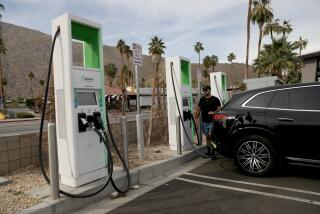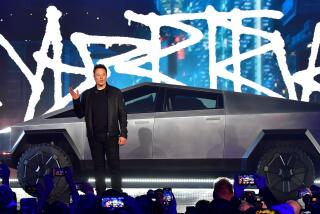Marketers Own the Electric Vehicle’s Future, Not Engineers
Even as California’s guidelines for “zero emission vehicles” accelerate into the regulatory fast lane, the prospects for electric cars keep crashing into criticism. They may be cute, the experts say, but they just don’t have the horses to compete with gas.
As one top automobile magazine put it, “The many drawbacks to such machines today are the small radius of action, slow speed, weight of batteries and cost and time taken to recharge.” Sniffed a highly respected auto executive: “The electric vehicle business has, up to date, been a rather sickly baby.”
But wait . . . the magazine quote comes from a 1903 issue of Overland Monthly, a leading automobile touring magazine of the day. The auto executive quote is circa 1906. Practically every hot technical and economic issue heard in today’s debates about electrics seems an eerie echo of the electric rhetoric heard back when the light bulb was young. Is this deja vu all over again?
The electric car story turns out to be one of the quirkiest serials in the history of American technology, featuring cameo appearances and star turns by industrial icons ranging from Thomas Alva Edison and Henry Ford to Charles Steinmetz and Samuel Insull. The electric car seemed like a good idea at the time--and still does. But good ideas don’t necessarily make successful innovations.
The bizarre tale of America’s un-consummated un-love affair with battery-powered broughams is neatly captured in the newly published “Taking Charge: The Electric Automobile in America” (Smithsonian Institution Press) by University of Arizona anthropologist Michael Brian Schiffer. It offers a provocative pop-culture explanation of why we still care more about miles per gallon than miles per volt.
*
From the very beginning, electric cars were seen as far cleaner, more reliable and more user friendly than their noxious, smoke-spewing gasoline cousins. With a range of 50 to 100 miles by 1910, Schiffer observes, electrics could be ideal for in-town driving and most commutes. What’s more, with the rise of electrification--and the rise of gasoline prices as Henry’s Fords became popular--the electric car seemed perfectly positioned to be a rival personal transportation technology.
That never happened, even though the greatest inventor of the age--Thomas Alva Edison--spent decades trying to create electric cars. Recognizing that the battery was the technological bottleneck, the Wizard of Menlo Park turned himself into a chemist in order to find the best mix of metals to carry a charge. He didn’t quite succeed.
In 1910, he tried to persuade Samuel Insull--the visionary electric utility magnate whose multibillion-dollar empire would later collapse in a sensational stock scandal--to use his networks to power a new generation of automobiles. Insull wouldn’t buy.
Two years later, Edison successfully persuaded Henry Ford (who had once worked at an electric utility himself) to launch a pilot program in electric cars. The resulting vehicles never escaped the prototype phase.
Of course, Edison was only the most famous of the electric evangelists and entrepreneurs who tried to jump-start the industry. Charles Steinmetz, General Electric’s technical genius, helped design a cheap electric runabout called the Dey that sold for $985 in 1917. By the end of the year, it had become the Edsel of electrics, failing to become, as “Electric Vehicles” magazine had hopefully predicted, “A Start Towards a Million Electrics.” Electrics never captured more than a tiny share of America’s automobile market.
Was this failure primarily technological? Economic? A gutless lack of vision by conservative utility executives who literally could not find a way to tap into what would become America’s biggest industry? Schiffer maintains the reasons have far less to do with technological infrastructures than with America’s macho pop culture of the era.
“The patriarchal family structure and the economic nature of the middle class is what doomed the electric car,” Schiffer insists.
At first, this smells like a parody of technology-scented Political Correctness. In fact, Schiffer makes a persuasive case that it was adventure-seeking males--not conservative family men--who fueled the explosion of gasoline-burning buggies. Back in those days, people didn’t buy automobiles to go to work or to the marketplace: They bought cars to go touring in the countryside.
*
“It was the leisure activities of the male, not the economic activities of the male, that determined what cars got bought,” Schiffer asserts. “These were Big Boys’ toys. . . . The allure of touring was that it was an adventure, so user friendliness and convenience weren’t very much factors at all in the early days. Cars didn’t need to be convenient or reliable in terms of having adventures. Having flat tires and asking people for help was part of the adventure. It wasn’t that electrics didn’t go fast--it was that you couldn’t go touring in them. . . .”
The earliest automobiles weren’t sold on functionality; they were sold on the romance of the open road. People took mass transit to go to work. Since the middle class of that day could only afford one car, it was invariably the touring car the male wanted, not the one that may have made the most economic sense. Indeed, Schiffer conclusively demonstrates that women were one of the best markets for those early electrics.
Consequently, the success of tomorrow’s electrics will lie less in pure technology or regulatory fiat than in how the vehicle is defined in the mind of pop culture, says Schiffer. Is being Green & Clean in the Nineties as compelling a market motivation as touring was in the Teens? Or does the electric car need its own James Dean as a martyr to the cause?
The most shocking point of “Taking Charge” isn’t that so many brilliant people tried and failed to make a go of the electric car but that, once again, capturing the public’s imagination seems so much more important than providing the most cost-effective technology.
Tomorrow’s electric car doesn’t belong to the engineers; it belongs to the marketers who can help people better find out who they are by buying an electric.
Michael Schrage is a writer, consultant and research associate at the Massachusetts Institute of Technology. He writes this column independently for The Times. He can be reached at schrage@latimes.com by electronic mail via the Internet.
*
More Innovation
* For a collection of recent Innovation columns by Michael Schrage, sign on to the TimesLink on-line service and “jump” to keyword “Innovation.”
Details on Times electronic services, B4






